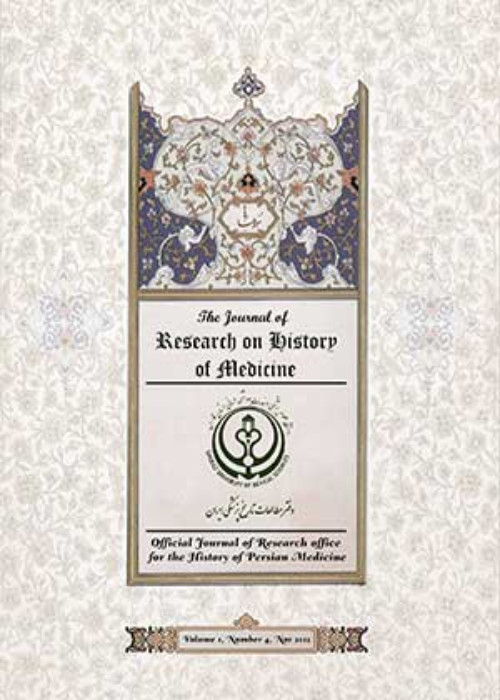فهرست مطالب
Journal of Research on History of Medicine
Volume:2 Issue: 3, Aug 2013
- تاریخ انتشار: 1392/06/09
- تعداد عناوین: 7
-
-
Page 79The history of Persia (Iran) dates back 10،000 years. Iranian history prior to the introduction of Islam in 637 AD is classified as ancient Persia but unfortunately، very little written evidence remains from that period. Furthermore، there is little current investigative research on this period of Iranian history، so it remains largely unclear، particularly in the case of medical scientific thought. The last period of this era was the Sassanid dynasty (224-637 AD). Some of the manuscripts remained from this period are written in the Pahlavic language، illuminating this dark period in the history of medical science. One of these ancient Pahlavic manuscripts is entitled “Bun-Dahišn”. It is analyzed in this paper to uncover ancient Persian wisdom on the female monthly menstrual cycle. The book is fundamentally about genesis and creation rather than medicine، but it holds valuable information about attitudes of the time to the female menstrual cycle. The manuscript describes the female menstrual cycle in terms of three phases. The first of which is the Pēš-ābest، phase of the female reproductive cycle; Ābast، refers to the second phase; and the third phase is termed Daštān and refers to the menstrual period itself. This is the principle concept conveyed in this manuscript، which can be related to current concepts of gynecology. However، in comparison with other ancient civilizations، it can be considered as a novel and advanced theory. Regarding this ancient text from a current perspective and in relation to modern knowledge in the field is an insightful way to track the progression of thought in gynecology.
-
Page 87Ali-Ibn-e-Abbas-Al-Majusi, well known as Haly Abbas in the West, a physician, surgeon and psychologist of Buyid dynasty era, lived in the 10th century (A.D). He, along with Tabari, Razi, Avicienna, and Jorjani, established the foundation of Islamic medicine. He authored “Kamilu Sina’at” or “al-Kitab al-Maliki” (The Royal Book), a book on medicine which was used in European universities until the 18th century. Al- Ma-jusi had an important role in promoting and discussing neuroscience, psychology, internal medicine, and basic medical sciences. Hence, ow-ing to his great contribution to the field of medicine, Al- Majusi deserves to be explored more through research.
-
Page 95One of the tragic consequences of the Great Wars is the spread of epi-demics. At the end of the First World War، flu spread in Europe and soon spread in many parts of the world including Iran. This event was accompanied by loss of many people in Shiraz. In two notes remained from that time، one belongs to a liberal and the other one belongs to one of the most famous physicians of Shiraz، the outbreak of flu is re-counted with precise details that can’t be found in the official sources. Therefore these two sources give us valuable information. In this pa-per، using these notes، Shiraz social situation is studied at the time of flu outbreak.
-
Page 103Since the time man observed his picture in the water, mirror has en-tered both man’s spiritual and material life. The role of mirror has un-dergone a lot of changes, ranging from foretelling to its use by barbers in different situations, to its use as warfare, mystic allegories, literal metaphors and historical narrations such as Alexander Mirror located in Alexandria. The present study aims to investigate the application of mirror in medicine in the past. Based on authentic traditional medical texts such as the Canon of Medicine (Avicenna) and Zakhireh (Trea-sure of)Kharazmshahi, a specific kind of mirror, called copper mirror or china (Chinese) mirror, was used to cure Bell palsy. In this article, we have investigated this specific type of therapy and have shown that china (Chinese) mirror, which has been referred to in some newer texts for the treatment of Bell palsy and some think it is made in China or maybe made of china, is, in fact, the very copper mirror mentioned in the older texs.
-
Page 109Ferdous al-Hekma book is one of the traditional medicine resources in the Islamic Civi-lization legacy. Ali ibn Rabn Tabari، its author، has lived in the third century AH. His-torians disagree on the author’s correct name، but the name of Ali ibn Rabn Tabari is of the most interest to them. This name seems more correctly because Rabn means “our teacher” in Judaism and the author of the book was Jewish and he stated in “Al-Din va al-Dola” book. Although Ibn Rabn had great skill in medicine، but medical was not his profession and he had a great love to writing. About his grace it is sufficient to say that Razi، Mas’udi، Hamavi and Biruni have cited to Ibn Rabn in their works. Ibn Rbn learnt Arabic، Syriac، medicine، geometry، philosophy، Hebrew and a little Greek in his father’s school. Because of its importance، Ferdous al-Hekma book was published in the University of Frankfurt in Germany in 1996. This book contains 7 types، 30 articles and 360 chapters. The major topics discussed in this book are: Nature of monsters and its related issues، Singular and combined temperaments، Educating children، Concept of the seasons، Food forces، Diseases of the eyes، nose، mouth، throat، stomach and heart…، The treatment of these diseases، Single and combined drugs، and The climate.


